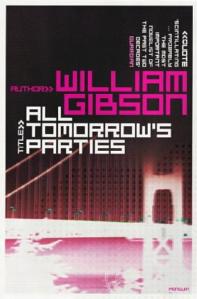
Cyberpunk is a subgenre of science fiction in a dystopian futuristic setting that tends to focus on a "combination of lowlife and high tech", featuring futuristic technological and scientific achievements, such as artificial intelligence and cybernetics, juxtaposed with societal collapse, dystopia or decay. Much of cyberpunk is rooted in the New Wave science fiction movement of the 1960s and 1970s, when writers like Philip K. Dick, Michael Moorcock, Roger Zelazny, John Brunner, J. G. Ballard, Philip José Farmer and Harlan Ellison examined the impact of drug culture, technology, and the sexual revolution while avoiding the utopian tendencies of earlier science fiction.
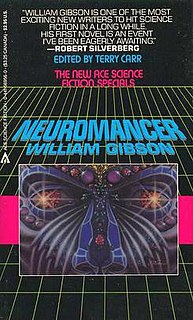
Neuromancer is a 1984 science fiction novel by American-Canadian writer William Gibson. Considered one of the earliest and best-known works in the cyberpunk genre, it is the only novel to win the Nebula Award, the Philip K. Dick Award, and the Hugo Award. It was Gibson's debut novel and the beginning of the Sprawl trilogy. Set in the future, the novel follows Henry Case, a washed-up hacker hired for one last job, which brings him in contact with a powerful artificial intelligence.

William Ford Gibson is an American-Canadian speculative fiction writer and essayist widely credited with pioneering the science fiction subgenre known as cyberpunk. Beginning his writing career in the late 1970s, his early works were noir, near-future stories that explored the effects of technology, cybernetics, and computer networks on humans—a "combination of lowlife and high tech"—and helped to create an iconography for the information age before the ubiquity of the Internet in the 1990s. Gibson coined the term "cyberspace" for "widespread, interconnected digital technology" in his short story "Burning Chrome" (1982), and later popularized the concept in his acclaimed debut novel Neuromancer (1984). These early works of Gibson's have been credited with "renovating" science fiction literature in the 1980s.

Mrs Dalloway is a novel by Virginia Woolf, published on 14 May 1925, that details a day in the life of Clarissa Dalloway, a fictional upper-class woman in post-First World War England. It is one of Woolf's best-known novels.
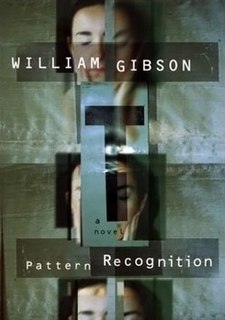
Pattern Recognition is a novel by science fiction writer William Gibson published in 2003. Set in August and September 2002, the story follows Cayce Pollard, a 32-year-old marketing consultant who has a psychological sensitivity to corporate symbols. The action takes place in London, Tokyo, and Moscow as Cayce judges the effectiveness of a proposed corporate symbol and is hired to seek the creators of film clips anonymously posted to the internet.
Intrusion Countermeasures Electronics (ICE) is a term used in cyberpunk literature to refer to security programs which protect computerized data from being accessed by hackers.

Virtual Light is a science fiction novel by American-Canadian writer William Gibson, the first book in his Bridge trilogy. Virtual Light is a science-fiction novel set in a postmodern, dystopian, cyberpunk future. The term 'Virtual Light' was coined by scientist Stephen Beck to describe a form of instrumentation that produces optical sensations directly in the eye without the use of photons. The novel was a finalist nominee for a Hugo Award, and shortlisted for the Locus Award in 1994.

Idoru is the second book in William Gibson's Bridge trilogy. Idoru is a science-fiction novel set in a postmodern, dystopian, cyberpunk future. One of the main characters, Colin Laney, has a talent for identifying nodal points, analogous to Gibson's own:
Laney’s node-spotter function is some sort of metaphor for whatever it is that I actually do. There are bits of the literal future right here, right now, if you know how to look for them. Although I can’t tell you how; it’s a non-rational process.
The Bridge trilogy is a series of novels by William Gibson, his second after the successful Sprawl trilogy. The trilogy comprises the novels Virtual Light (1993), Idoru, (1996) and All Tomorrow's Parties (1999). A short story, "Skinner's Room", was originally composed for Visionary San Francisco, a 1990 museum exhibition exploring the future of San Francisco.
"Skinner's Room" is a science fiction short story by American-Canadian author William Gibson, originally composed for Visionary San Francisco, a 1990 museum exhibition exploring the future of San Francisco. It features the first appearance in Gibson's fiction of "the Bridge", which Gibson revisited as the setting of his acclaimed Bridge trilogy of novels. In the story, the Bridge is overrun by squatters, among them Skinner, who occupies a shack atop a bridgetower. An altered version of the story was published in Omni magazine and subsequently anthologized. "Skinner's Room" was nominated for the 1992 Locus Award for Best Short Story.
Cayce Pollard is the fictional protagonist of William Gibson's 2003 novel Pattern Recognition.
Sindome is a cyberpunk MOO video game. It has been online since 1997, and there are typically between 60 and 100 players online and roleplaying at any time.

The works of William Gibson encompass literature, journalism, acting, recitation, and performance art. Primarily renowned as a novelist and short fiction writer in the cyberpunk milieu, Gibson invented the metaphor of cyberspace in "Burning Chrome" (1982) and emerged from obscurity in 1984 with the publication of his debut novel Neuromancer. Gibson's early short fiction is recognized as cyberpunk's finest work, effectively renovating the science fiction genre which had been hitherto considered widely insignificant.
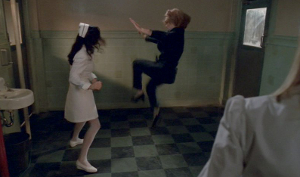
"Kill Switch" is the eleventh episode of the fifth season of the science fiction television series The X-Files. It premiered in the United States on the Fox network on February 15, 1998. It was written by William Gibson and Tom Maddox and directed by Rob Bowman. The episode is a "Monster-of-the-Week" story, unconnected to the series' wider mythology. "Kill Switch" earned a Nielsen household rating of 11.1, being watched by 18.04 million people in its initial broadcast. The episode received mostly positive reviews from television critics, with several complimenting Fox Mulder's virtual experience. The episode's name has also been said to inspire the name for the American metalcore band Killswitch Engage.
"First Person Shooter" is the thirteenth episode of the seventh season of the science fiction television series The X-Files. It premiered on the Fox network in the United States on February 27, 2000. The episode is a "Monster-of-the-Week" story, unconnected to the series' wider mythology. "First Person Shooter" was watched by 15.31 million people in its initial broadcast, with a 9.3 Nielsen household rating. The episode received mostly negative reviews from critics.
Rei Toei is a fictional character in the Bridge trilogy of speculative fiction novels by William Gibson. Rei is introduced as the title character in Gibson's 1995 novel Idoru, as an artificial intelligence, an embodied agent simulating a human female idol singer. A personality construct which adapts and learns from her interaction with humans, she irresistibly attracts data analyst protagonist Colin Laney.
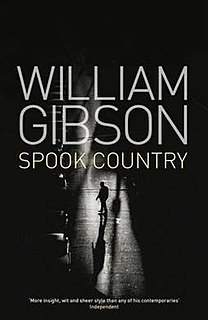
Spook Country is a 2007 novel by speculative fiction author William Gibson. A political thriller set in contemporary North America, it followed on from the author's previous novel, Pattern Recognition (2003), and was succeeded in 2010 by Zero History, which featured much of the same core cast of characters. The plot comprises the intersecting tales of three protagonists: Hollis Henry, a musician-turned-journalist researching a story on locative art; Tito, a young Cuban-Chinese operative whose family is on occasion in the employ of a renegade ex-CIA agent; and Milgrim, a drug-addled translator held captive by Brown, a strangely authoritarian and secretive man. Themes explored include the ubiquity of locative technology, the eversion of cyberspace and the political climate of the United States in the aftermath of the September 11, 2001 attacks.
The Sanchez Art Center is a nonprofit arts organization located in Pacifica, California. It was formed in 1996 by local artists and community members.
